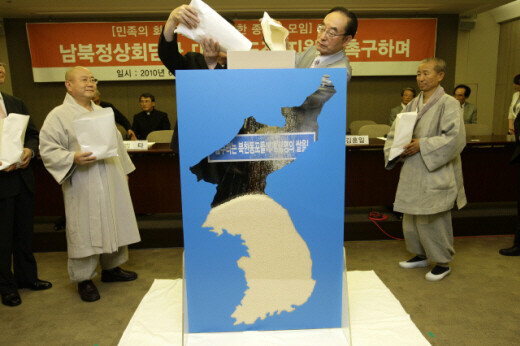hankyoreh
Links to other country sites 다른 나라 사이트 링크
Coalition calls for rice aid to N.Korea instead of animal feed program

By Kim Hyeon-dae and Hwang Choon-hwa
Following the Lee Myung-bak administration’s announcement of plans to use a portion of the country’s 1.4 million tons in rice stores for animal feed, there has been a rapid rise in calls to send the rice surplus to North Korea instead.
The five opposition parties, including the main opposition Democratic Party (DP), and 35 groups, including the Korean Peasants’ League, held a press conference Wednesday in front of Seoul’s Sejong Center for the Performing Arts where they announced that they were forming a “Citizens’ Campaign for Sending Unification Rice to Realize Peace on the Korean Peninsula.”
“As rice aid to North Korea and private interchanges with North Korea have halted over the two years of the Lee Myung-bak administration, the great achievements in national reconciliation and Korean Peninsula peace made over the past decade have come crashing down in an instant,” said the group in a statement for the press conference. “Rice that was once provided to North Korea on the order of 400 thousand tons per year has simply piled up over the past two years, sending rice prices crashing and causing suffering for farmers.”
Indeed, during the two years that rice aid to North Korea has been suspended, rice stores have risen to 1.4 million tons, twice the optimum amount of 720 thousand tons. This is also wreaking havoc on rice prices, which have plummeted by some 15 percent in the space of a year.
The new group plans to expand the unification rice effort into a mass movement through fund-raising, joint unification rice cultivation, and bazaars.
“Rice aid to North Korea is a realistic approach to alleviating the current rice woes,” said Jeon Chang-ik, head of the agricultural policy department at the Nonghyup Economic Research Institute. “Since there is a surplus of some 400 thousand tons of rice every year, eight percent of total yearly production, there really is no effective method besides minimizing that surplus immediately by sending that much overseas to alleviate the current rice problems.”
Jeon said that aid to North Korea is the “only realistic short-term rice measure,” but cautioned that a rice production coordination system must be introduced simultaneously as a fundamental measure for addressing the surplus.
Many have questioned the Lee administration’s plan to use surplus rice stores for animal feed.
“I would like to ask them how there can be surplus rice to release as food for pigs and cattle, but none to give as humanitarian aid to starving North Koreans,” said Kim Bong-yng, 45, leader of the farmers’ association in Gurye, South Jeolla Province.
The Ministry for Food, Agriculture, Forestry and Fisheries (MIFAFF) has defended the policy.
“The rice stores for 2005 that have been targeted for disposal as feed amount to just 110 thousand tons,” said an MIFAFF official in response. “Using the rice stores as aid to North Korea could provide us with a way out of this situation, but MIFAFF cannot demand the resumption of aid in light of the Cheonan situation.”
Meanwhile, data from a recent Korea Rural Economic Institute analysis of North Korean agricultural activity predicted that the North Korean food situation for 2010 would be more difficult than in 2009.
“Since 2008, food aid to North Korea has been almost completely cut off not only by us but by the United States and the international community,” said Dr. Kim Young-hoon, who compiled the report for KREI. “Since even fertilizer aid has been discontinued, there is nothing whatsoever to lead us to believe that North Korea’s harvest will be any better than last year.”
Please direct questions or comments to [englishhani@hani.co.kr]
Editorial・opinion
![[Column] Park Geun-hye déjà vu in Yoon Suk-yeol [Column] Park Geun-hye déjà vu in Yoon Suk-yeol](https://flexible.img.hani.co.kr/flexible/normal/500/300/imgdb/original/2024/0424/651713945113788.jpg) [Column] Park Geun-hye déjà vu in Yoon Suk-yeol
[Column] Park Geun-hye déjà vu in Yoon Suk-yeol![[Editorial] New weight of N. Korea’s nuclear threats makes dialogue all the more urgent [Editorial] New weight of N. Korea’s nuclear threats makes dialogue all the more urgent](https://flexible.img.hani.co.kr/flexible/normal/500/300/imgdb/original/2024/0424/7317139454662664.jpg) [Editorial] New weight of N. Korea’s nuclear threats makes dialogue all the more urgent
[Editorial] New weight of N. Korea’s nuclear threats makes dialogue all the more urgent- [Guest essay] The real reason Korea’s new right wants to dub Rhee a founding father
- [Column] ‘Choson’: Is it time we start referring to N. Korea in its own terms?
- [Editorial] Japan’s rewriting of history with Korea has gone too far
- [Column] The president’s questionable capacity for dialogue
- [Column] Are chaebol firms just pizza pies for families to divvy up as they please?
- [Column] Has Korea, too, crossed the Rubicon on China?
- [Correspondent’s column] In Japan’s alliance with US, echoes of its past alliances with UK
- [Editorial] Does Yoon think the Korean public is wrong?
Most viewed articles
- 1[Column] Park Geun-hye déjà vu in Yoon Suk-yeol
- 2N. Korean hackers breached 10 defense contractors in South for months, police say
- 3Thursday to mark start of resignations by senior doctors amid standoff with government
- 4[Editorial] New weight of N. Korea’s nuclear threats makes dialogue all the more urgent
- 5Kim Jong-un expressed ‘satisfaction’ with nuclear counterstrike drill directed at South
- 6Will NewJeans end up collateral damage in internal feud at K-pop juggernaut Hybe?
- 7[Editorial] Japan’s rewriting of history with Korea has gone too far
- 8[Cine feature] A new shift in the Korean film investment and distribution market
- 9[Column] ‘Choson’: Is it time we start referring to N. Korea in its own terms?
- 10[Column] The clock is ticking for Korea’s first lady